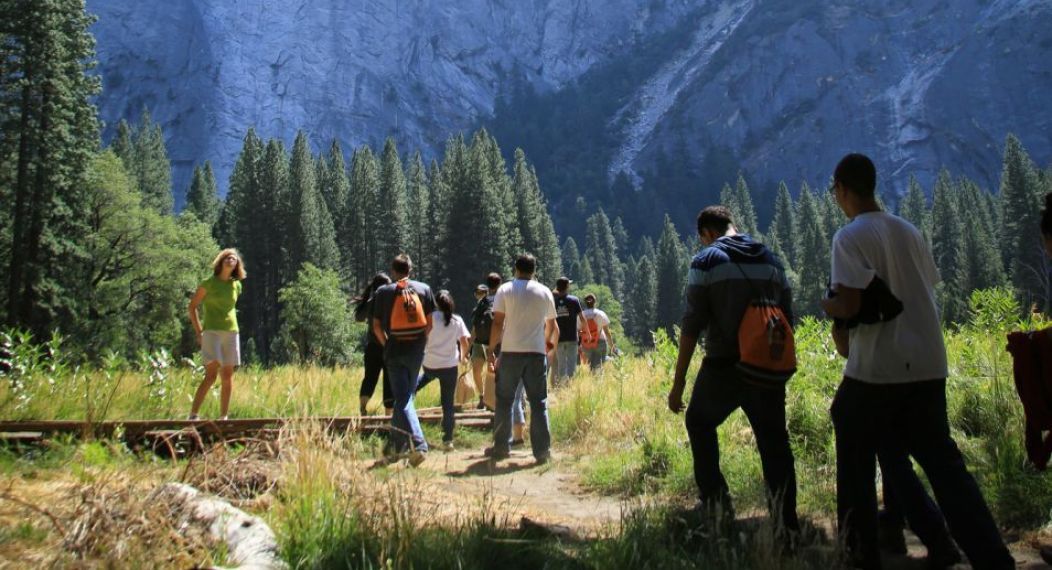Join us for explorations and discussions of the natural wonders of the west. Participants will complete coursework through email as well as participate in an excursion to each locale to see the geology, plants, and animals firsthand. You must attend the trip to receive credit for the course. These courses will be useful to anyone teaching natural sciences — most of the California State Earth Science Standards are covered. Those with a general interest in and appreciation for our National Parks and wild places are also welcome!
On our first day we will meet in Livingston, Montana and head east toward Big Timber. Our first stops will include a discussion of the Mesozoic landscape of Montana, including the dinosaur-bearing Hell Creek Formation. At Big Timber we will head south, drive up Boulder River Canyon making stops on our way to Natural Bridge Falls. We will return to McLeod and loop back to Livingston along the West Boulder River.
We will again meet in Livingston on Day 2 and head south driving along the Yellowstone River through Paradise Valley. Our stops will include features of the Yellowstone Outlet Glacier, Petrified trees of the Tom Miner basin, 3-billion-year-old rocks in Yankee Jim Canyon, Devils Slide, and a boulder field deposited by glacial outburst floods. We will end the day near Gardiner, MT.
Date: July 21-22, 2025
Code: PEDD 9644
On our first day we will meet at the Albright Visitor Center in Mammoth Hot Springs. We will travel east on the North Loop Road to Tower Junction then east through the Lamar Valley to Cooke City. Stops will include Undine Falls, Petrified Tree, Glacial Erratics, Soda Butte, Heart Mountain Detachment. We will spend the night in Cooke City.
On Day 2 we will traverse the Beartooth Plateau from Cooke City to Rock Creek Overlook. Our stops will include Crazy Creek, Clarks Fork Overlook, Clay Butte, Beartooth Lake, Beartooth Pass, Rock Creek Overlook.
Date: July 23-24, 2025
Code: PEDD 9645
This class will offer the student a look at the eastern part of Yellowstone Country. We will travel east from Cooke City, down the Clarks Fork of the Yellowstone River along the Chief Joseph Scenic Highway. This route passes through one of the most scenic areas in Wyoming. Among the fans of this country was Ernest Hemingway who wrote “Death in the Afternoon” while staying at the L Bar T Ranch on Clarks Fork in the summer of 1930. The geology here is spectacular. We will see evidence of the uplift of the Beartooth Plateau and the Heart Mountain Detachment, a landslide the traveled at 500 miles per hour and slid for 50 miles. We will end the first day in Cody Wyoming with time for dinner and a visit to the Buffalo Bill Cowboy Museum.
Our second day will take us west along the Shoshone River back into Yellowstone Park at the East Entrance Station. After viewing hoodoos and 2 billion year old rock, we will top Sylvan Pass (8530 feet) and stop at Mary Bay to see evidence of the largest hydrothermal explosion crater in the world. From Mary Bay we will skirt the north end of Yellowstone Lake and end the day at Fishing Bridge, a small resort within the park.
Date: July 25-26, 2025
Code: PEDD 9616
At 13,770 feet the Grand Teton rises over 7,000 feet above Jackson Hole. Twelve other peaks of the Teton Range reach over 12,000 feet in elevation. The Teton Range has moved up along the Teton fault a total of 24,000 feet forming one of the most dramatic ranges in all of the Rockies. This trip will explore the geologic and glacial history of the Teton Range and Jackson Hole. We will also discuss the major plant and animal communities.
On line presentations will be followed by a 2 day field trip to Grand Teton National Park. On the first day stops include Lewis Falls, Signal Mountain, Jenny Lake, Taggart Lake, and Teton Village Aerial Tramway. On the second day we will travel to the Grand Teton National park Visitor Center at Moose, Blacktail Butte, the Gros Ventre slide and the Snake River Overlook.
Date: July 27-28, 2025
Code: PEDD 9608
Day one stops will include: Mono Lake Overlook, Bennettville, Nunatak Nature Trail, Dana Meadows, Lee Vining Canyon Overlook and Warren Bench.
Day two stops include: Panum Crater, South Tufa Reserve, Aeolian Buttes, Mill Creek Delta, Black Butte and the Old Marina.
We will discuss the geologic history of the Sierra Nevada Mountains, the effects of glaciers on the range, mining history of Bennettville and the natural and human history of Mono Lake.
Date: September 27-28, 2025
Code: PEDD 9639
Sequoia and Kings Canyon National Parks are the home of awe-inspiring geological features and resources. The parks contain a significant portion of America’s longest mountain range, the Sierra Nevada. Included in the Parks’ mountainous landscape is the tallest mountain in the contiguous United States, Mt. Whitney, which rises to 14,491 feet above sea level. Eleven additional peaks taller than 14,000 feet are also found along the parks’ eastern boundaries at the crest of the Sierra Nevada. This course will include discussions of the origins, uplift, and sculpting of the Kings Canyon landscape. The geologic history of the 400 mile long Sierra Nevada mountain range will be discussed along with the many glacial features responsible for the Kings Canyon scenery. Other discussion topics will include plant and animal adaptations and Native American history.
Online presentations will be followed by a 2 day field trip. Field trip stops will include: Panorama Point, Junction View, Horseshoe Bend, Chevron Folds, Roaring River Falls, Zumwalt Meadow, Roads End, Muir Rock, General Grant Grove, Giant Forest Museum, Moro Rock, and Crystal Cave.
Date: October 18-19, 2025
Code: PEDD 9617
The rock formations of Joshua Tree National park are not only visually stunning but also offer insight into the 1.7 billion year history of this spectacular National Park. This course will enable us to piece together the history of this region and much of California and the western US. Topics will include plate tectonics, climate and weather, rock identification, plant and animal adaptations and the interaction of life, land and climate. We will also take an excursion to surface ruptures of the 1992 Landers Earthquake. This 7.3 magnitude quake is one of the largest in California’s recorded history.
Date: December 6-7, 2025
Code: PEDD 9601
On October 31st, 1994 Death Valley was designated a National Park. With 3.3 million acres it is the largest National Park in the contiguous United States. It includes the lowest point in the western hemisphere (282 feet below sea level) and, in 1913, an air temperature of 134 degrees F was recorded. This land of extremes offers a fascinating look at plant and animal adaptive strategies, faulting, volcanism, and human history. On-line presentations will be followed by a field trip to Death Valley.
Date: January 24-25, 2026
Code: PEDD 9612
Class Requirements
- View a Power Point presentation
- Attend a two-day field trip
- Students are responsible for lodging, food and transportation
- Field trips begin at 9 a.m. and end between 4 p.m. and 5 p.m.
- We car caravan from stop to stop
- Walks are usually one to three miles round trip
- Participants should be in reasonably good physical shape
- Field trip gear list:
- clothing appropriate for weather
- lunch, water, paper, pen, camera
- Submit a field trip report
- Submit to Instructor Ted Reeves tedpzmz@gmail.com
- The report is due one week after the end of the trip
- Field Trip Report must include:
- information and photos from each stop
- further on-line research on major topics
- report should represent about 8 hours of work
- the format can be Word, Pages, Power Point, Keynote
- Vehicles should be in good mechanical condition and arrive with a full tank of gas on the first day
Additional Information
- Each class is worth 3 semester units.
- Class tuition is $350. Non-credit tuition is $150.
- These courses are designed to meet professional development needs of educators for career and salary advancement and is not applicable to a degree at University of the Pacific.
- District approval is recommended before enrolling. An official transcript is available from Pacific upon successful completion of coursework.
- All field trip participants must register for the class. Non-credit tuition is $150.
- At any activities or events sponsored by this program, the University does not provide insurance coverage for non-registered students. The University does not sponsor, sanction, or cover non-registered students for any purpose.
Benerd College believes in making education accessible and meeting learners where they are at. Also, we are passionate about being a trusted and agile community partner. Here are a few ways to engage with us.




